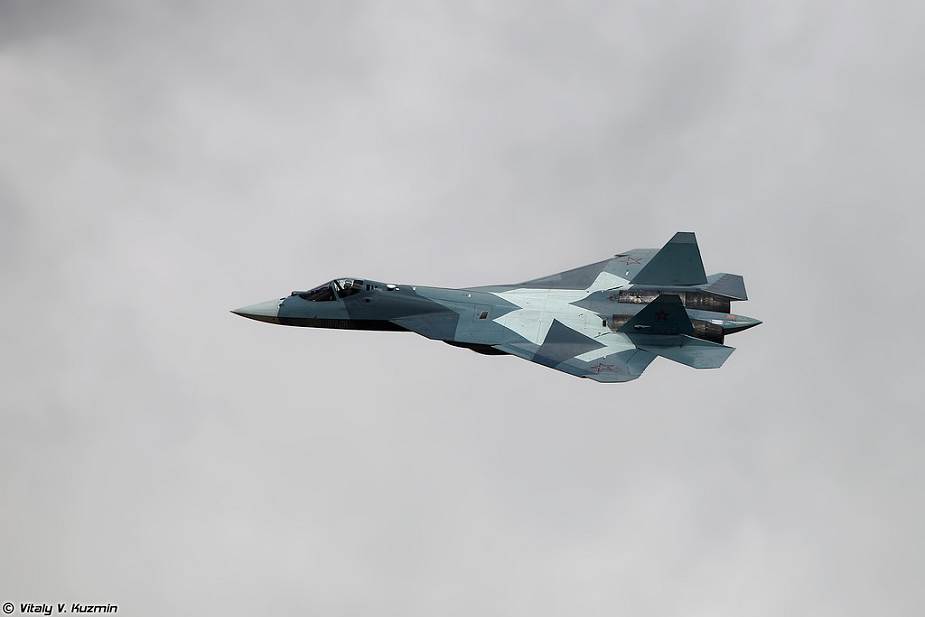According to information published by the Russian press agency Tass on December 28, 2020, the first serial fifth-generation Su-57 fighter jet was shipped to the 929th flight test center (GLITs) in Akhtubinsk. It had to be supplied yet in 2019 but crashed. PAK FA program is the most difficult and ambitious project for Russian aircraft makers, the Izvestia daily writes.
Follow Air Recognition on Google News at this link
 Sukhoi Su-57 / T-50 PAK FA fighter aircraft at Maks AirShow near Moscow, July 2015. (Picture source Vitaly Kuzmin)
Sukhoi Su-57 / T-50 PAK FA fighter aircraft at Maks AirShow near Moscow, July 2015. (Picture source Vitaly Kuzmin)
Su-57 with onboard number 01 blue was seen in Novosibirsk on December 25. It made a stopover on the way from Komsomolsk-on-Amur to European Russia. It is the first serial aircraft of the development batch of the latest jets. It made the maiden flight in October 2020.
The Su-57 is a stealth, single-seat, twin-engine multirole fifth-generation jet fighter aircraft designed and manufactured by the Russian company Sukhoi. Although most information is classified, sources within the Sukhoi company and Defence Ministry have openly stated that the aircraft is to be stealthy, supermaneuverable, have supercruise capability, incorporate substantial amounts of composite materials, and possess advanced avionics such as active phased-array radar and sensor fusion.
GLITs (flight test center) sources said trials of the first serial jet are ongoing. Pilots and instructors are designing a training program for its pilots. Russian Defense Minister Sergey Shoigu said 22 Su-57 are to be supplied by the end of 2024 and the number will grow to 76 by 2028.
The contract for a major batch of fighter jets was signed according to a personal instruction of the Russian president. Before it, the Aerospace Forces had to receive only 16 latest jets. The increased output helped drop the price of each jet 20 percent.
The contracts allow arming three air regiments with Su-57. New contracts for additional jets are likely in the future. Over ten Su-57 prototypes are currently engaged in flight trials.
The supplies of serial jets will gradually increase from 2021 and the full projected capacity is to be reached after 2024. Sixteen jets will be annually produced.
The Russian Defense Ministry had to receive the first serial Su-57 in late 2019, but a crash disrupted the plan. The pilot ejected to safety during a test flight on December 24, 2019. A new fighter jet will be built to replace the crashed one.
The delivery of fighter jets was postponed for a year to clarify the reasons for the crash. The investigation helped make Su-57 better. The production program had to be adjusted to deal with the delay.
Accidents have already delayed trials. On June 10, 2014, the engine of the fifth prototype caught fire. The damage was great and the glider of the jet had to be rebuilt actually from scratch.
Rostec Executive Director Oleg Yevtushenko said the prototypes had made several thousand test flights by the spring of 2020. In 2018-2019, Su-57 were twice engaged in Syria to test weapons against real targets. General Chief-of-Staff Valery Gerasimov said they successfully fulfilled the missions.
In 2020, Su-57 operated together with other fighter jets and bombers. They were previously tested together with heavy Okhotnik S-70 drone.
The jets are upgraded as batch production develops. In October 2018, Megapolis R&D was launched to create an upgraded Su-57 of the second phase by 2024.
The upgraded prototype is to make the maiden flight in 2022. Trials are to be completed in late 2024. Most of the 76 jets stipulated by the contract will be produced in the upgraded option.
The main difference is a new engine known as item 30 designed for Su-57. So far, the first jets are powered by AL-41F1 engines.
Su-57 made the first flight with the new engine in December 2017. The engine has a characteristic saw-tooth pattern of the nozzle. It decreases radar and other signatures. Item 30 will have a bigger resource and provide supersonic speed without a boost in cruising flight.
The upgraded option of the fighter jet will have a broader range of arms. Several precision missiles and bombs are being designed. They will be carried inside the jet.
The Megapolis R&D also designs a new panoramic indicator, multifunctional displays and a wide-angle sight. Electric drivers of the steering surfaces will increase the already excellent maneuverability, the Izvestia said.
© Copyright 2020 TASS. All rights reserved. This material may not be published, broadcast, rewritten or redistributed.
















